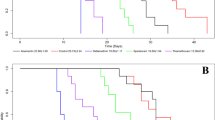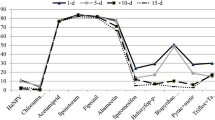Abstract
Adults of the parasitoid Hyposoter didymator were topically treated with four insect growth regulator (IGR) insecticides at different doses, including their respective maximum field recommended concentrations (MFRCs) [registered in Spain or recommended by manufacturers]. Methoxyfenozide and tebufenozide (100, 500 and 1,000 mg/l) did not affect any life parameter or the first parasitoid’s offspring. In contrast, diflubenzuron (100, 500 and 1,000 mg/l) and pyriproxyfen (75, 500 and 1,000 mg/l) caused sublethal effects, decreasing the offspring emergence as a result of the parasitoid mortality during its immature stages inside the host and the life span of female offspring. In a second part, pharmacokinetic studies using a 14C isotope of each IGR showed similar patterns of penetration through the cuticle, but different absorption and distribution rates inside the insect body. Cuticular penetration of pyriproxyfen reached about 99% in 3 days and those of diflubenzuron, methoxyfenozide and tebufenozide ranged from 82% to 86%. All insecticides were recovered from the reproductive system of insects and eggs. For pyriproxyfen and diflubenzuron absorption in the adult body tissues reach >65%, whereas this was only 40% for tebufenozide and methoxyfenozide. No statistical differences were found between sexes. The current data reflect that several mechanisms are likely to be involved in the selectivity of these products towards this parasitoid.




Similar content being viewed by others
References
Bozsik A (2006) Susceptibility of adult Coccinella setempunctata (Coleoptera: Coccinellidae) to insecticides with different modes of action. Pest Manage Sci 62:651–654
Chen T-Y, Liu TX (2002) Susceptibility of immature stages of Chrysoperla rufilabris (Neurop., Chrysopidae) to pyriproxyfen, a juvenile hormone analog. J Appl Entomol 126:125–129
DeBach P, Rosen D (1991) Biological control by natural enemies. Cambridge University Press, Cambridge
Dhadialla TS, Carlson GR, Le DP (1998) New insecticides with ecdysteroidal and juvenile hormone activity. Annu Rev Entomol 43:545–569
Farinós GP, Smagghe G, Tirry L, Castañera P (1999) Action and pharmacockinetics of a novel insect growth regulator, halofenozide, in adult beetles of Aubeonymus mariafranciscae and Leptinotarsa decemlineata. Arch Insect Biochem Physiol 41:201–213
Figueiredo E, Mexıa A (2000) Parasitoid complex associated with Lepidoptera on horticultural protected crops in the west region of Portugal. Bull IOBC/SROP 23:205–208
Hassan SA (1994) Activities of the IOBC/wprs working group “Pesticides and beneficial organisms’’. Bull IOBC/wprs 17:1–5
Hasseb M, Amano H (2002) Effect of contact, oral and persistent toxicity of selected pesticides on Cotesia plutellae (Hym., Braconidae), a potential parasitoid of Plutella xylostella (Lep., Plutellidae). J Appl Entomol 126:8–12
Ishaaya I, De Cock A, Degheele D (1994) Pyriproxyfen, a potent suppresser of egg hatch and adult formation of the greenhouse whitefly (Homoptera: Aleyrodidae). J Econ Entomol 87:1185–1189
Kogan M (1998) Integrated pest management. Historical perspectives and contemporary developments. Annu Rev Entomol 43:243–270
Liñán De C (2002) Vademecum de productos fitosanitarios y nutricionales 2003. In: Liñán C (ed) Ediciones Agrotécnicas SL, Madrid, Spain, 671 pp
Liu TX, Chen T-Y (2001) Effects of a juvenile hormone analog, pyriproxyfen, on the apterous form of Lipaphis erysimi. Entomol Exp Appl 98:295–301
Medina P, Smagghe G, Tirry L, Viñuela E (2002) Significance of penetration, excretion and transovarial uptake to toxicity of three insect growth regulators in predatory lacewing adults. Arch Insect Biochem Physiol 51:91–101
Mommaerts V, Sterk G, Smagghe G (2006a) Bumblebees can be used in combination with juvenile hormone analogues and ecdysone agonists. Ecotoxicology 15:513–521
Mommaerts V, Sterk G, Smagghe G (2006b) Hazards and uptake of chitin synthesis inhibitors in bumblebees Bombus terrestris. Pest Manage Sci 62:752–758
Nation JL (2002a). Hormones and development. In: Nation JL (ed) Insect physiology and biochemistry. CRC publisher, New York, pp 119–155
Nation JL (2002b). Integument. In: Nation JL (ed) Insect physiology and biochemistry. CRC publisher, New York, pp 89–118
Newman MC, Unger MA (2003) Uptake, biotransformation, detoxification, elimination, and accumulation. In: Newman MC, Unger MA (eds) Fundamentals of ecotoxicology, 2nd edn. CRC publisher, Boca Raton, pp 53–73
Pineda S, Smagghe G, Schneider MI, Del Estal P, Viñuela E, Martinez AM, Budia F (2006) Toxicity and pharmacokinetics of spinosad and methoxyfenozide to Spodoptera littoralis (Lepidoptera: Noctuidae). Environ Entomol 35:856–864
Reynolds SE (1987) The cuticle, growth and molting in insects: the essential background to the action of acylurea insecticides. Pestic Sci 20:131–146
Ruberson JR, Remoto H, Hirose Y (1998) Pesticides and conservation of natural enemies in pest management. In: Barbosa P (ed) Conservation biological control. Academic Press, New York, pp 207–220
Schneider M, Smagghe G, Gobbi A, Viñuela E (2003) Toxicity and pharmacokinetics of seven novel insecticides on pupae of Hyposoter didymator (Hymenoptera: Ichneumonidae), a parasitoid of early larval instars of lepidopteran pests. J Econ Entomol 96:1054–1065
Schneider M, Smagghe G, Pineda S, Viñuela E (2004a) Action of insect growth regulator insecticides and spinosad on life history parameters and absorption in third instar larvae of the endoparasitoid Hyposoter didymator. Biol Control 31:189–198
Schneider MI, Smagghe G, Viñuela E (2004b) Comparative effects of several insect growth regulators and spinosad on the different developmental stages of the endoparasitoid Hyposoter didymator (Thunberg). Bull IOBC/wprs 27:13–20
Schneider M, Viñuela E (2007) Improvements in rearing method for Hyposoter didymator, considering sex allocation and sex determination theories used for Hymenoptera. Biol Control 43(3):271–277
Smagghe G, Degheele D (1994) The significance of pharmacokinetics and metabolism to the biological activity of RH-5992 (tebufenozide) in Spodoptera exigua, Spodoptera exempta and Leptinotarsa decemlineata. Pestic Biochem Physiol 49:224–234
Torres-Vila LM, Rodríguez-Molina MC, Palo E, Del Estal P, Lacasa A (2000) The parasitoid complex of Helicoverpa armigera Hb. on tomatoes in vegas del Guadiana plains (Extremadura). Boletín de Sanidad Vegetal: Plagas 26:323–333 (In Spanish)
Viñuela E (1998) Insect resistance to insecticides in Spain. Boletín de Sanidad Vegetal: Plagas 24:487–496 (In Spanish)
Willrich MM, Boethel DJ (2001) Effects of diflubenzuron on Peudoplusia includens (Lepidoptera: Noctuidae) and its Parasitoid Copidosoma floridanum (Hymenoptera: Encyrtidae). Environ Entomol 30:794–797
Zar JH (1996) Bioestatistical analysis, 3rd edn. Prentice Hall Publisher, New Jersey, USA, 662 pp
Acknowledgements
This research was partially supported by Project AGF99-1135 to E. Viñuela (Spanish Ministry of Education and Culture) and fellowship to S. Pineda from CONACYT (Mexican Ministry of Education). M.I. Schneider acknowledges from CONICET (Argentine Ministry of Education and Culture) and G. Smagghe the Fund for Scientific Research (FWO-Vlaanderen, Brussels, Belgium). Authors are grateful to Homi Dara Schroff for reviewing the English style which have contributed to clarify the manuscript. They are also indebted to two anonymous reviewers for constructive criticism.
Author information
Authors and Affiliations
Corresponding author
Rights and permissions
About this article
Cite this article
Schneider, M., Smagghe, G., Pineda, S. et al. The ecological impact of four IGR insecticides in adults of Hyposoter didymator (Hym., Ichneumonidae): pharmacokinetics approach. Ecotoxicology 17, 181–188 (2008). https://doi.org/10.1007/s10646-007-0182-9
Received:
Accepted:
Published:
Issue Date:
DOI: https://doi.org/10.1007/s10646-007-0182-9




